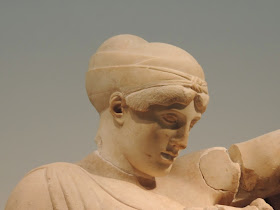 |
| "Cosy Coddles" egg cosy |
The local branch of the Knitting & Crochet Guild met just before Easter (on Maundy Thursday) and we had a seasonal theme - knitting egg cosies. The pattern was designed by Ann Kingstone, and featured several of her favourite techniques, including stranded knitting, provisional cast-on, i-cord and applied i-cord, and she was on hand to help with difficulties.
No-one managed to finish their cosy during the meeting, though most got a lot further than I did. In fact, I started again later - in spite of my extensive collection of knitting needles, I hadn't been able to find any double pointed needles of the right size, so I was using a circular needle and finding it very awkward to use the magic loop technique on such a small item. So last week I bought a set of dpns and started again, and here's the finished cosy.
There are three panels, with designs that Ann based on some Dutch embroidery. The loop at the top is i-cord, and there's an applied i-cord strip at the base of the cosy. The applied i-cord separates the outer layer (in stranded knitting) from a plain knitted lining - with two layers of wool, it would indeed keep an egg cosy.
Not sure what I'm going to do with it now, because we very rarely eat boiled eggs... But I'm pleased that I finished it successfully, and it looks very pretty.






























